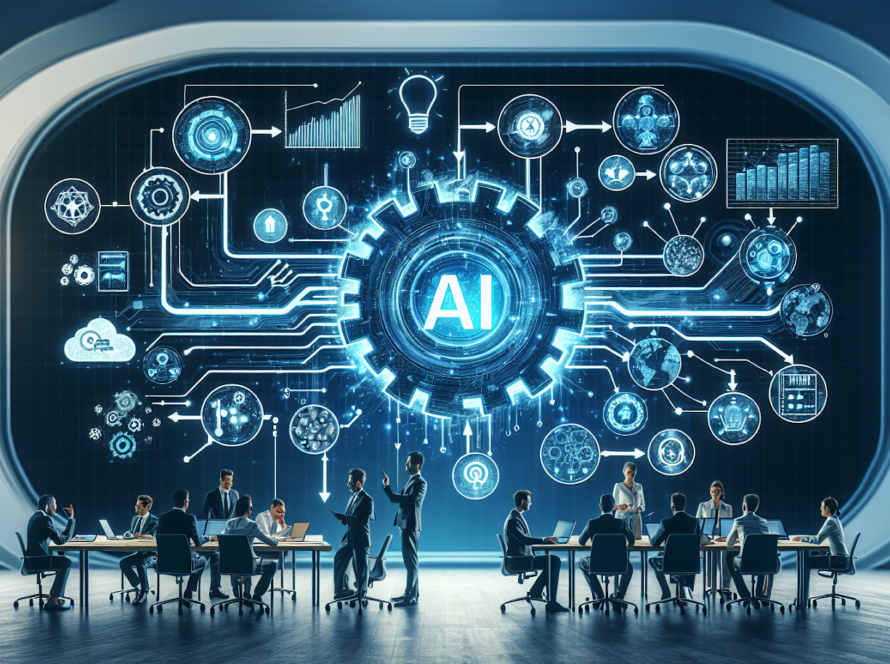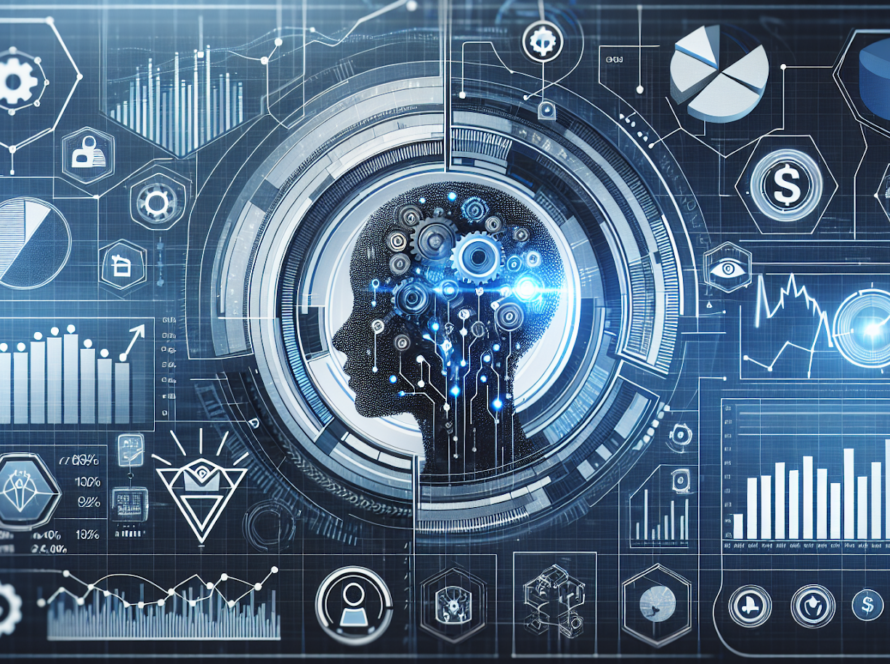In the ever-evolving landscape of artificial intelligence, staying abreast of the latest improvements is not just a matter of professional growth for AI consultants—it’s a competitive necessity. The recent advancements in AI have been nothing short of revolutionary, offering new tools and capabilities that can redefine how we approach problems and unlock unprecedented potential across various industries. In this exploration, we’ll delve into some of the most significant improvements in AI technology that consultants should be leveraging to stay at the forefront of innovation.
Natural Language Processing (NLP)
At the heart of many AI systems lies Natural Language Processing (NLP), a field that has seen tremendous growth and improvement. NLP enables machines to understand, interpret, and generate human language in a way that is both meaningful and useful. Let’s explore some key areas where NLP has made leaps forward.
Advanced Language Models
Language models are the engines driving today’s most sophisticated NLP applications. These models have grown exponentially in their ability to grasp context, nuance, and even cultural subtleties within language.
GPT-4 and Beyond
The introduction of GPT-4 by Company ABC represents a quantum leap over its predecessors. As an AI consultant, you might recall how GPT-3 was lauded for its impressive language generation capabilities—well, GPT-4 takes it several steps further. With an even larger dataset and more refined algorithms, GPT-4 boasts enhanced comprehension and response accuracy. This means more nuanced conversation flows and better understanding in customer service bots, more insightful analysis in data interpretation tasks, and overall superior performance in any application involving human-like text generation.
Multilingual Capabilities
The world speaks thousands of languages, but until recently, many NLP systems were predominantly English-centric. The latest models now offer robust multilingual capabilities without sacrificing quality or depth of understanding. For global businesses or those looking to expand into new markets, these multilingual features are indispensable tools for communication and analysis across diverse linguistic landscapes.
Enhanced Text Generation and Summarization
AI-powered text generation has moved beyond simple article spinning or content creation; it now encompasses advanced summarization tools that can distill lengthy documents into concise summaries without losing essential information. This capability is particularly beneficial for consultants who need to quickly assimilate vast amounts of data or provide executive summaries to clients who may not have time to pore over detailed reports.
Improved Sentiment Analysis Tools
Sentiment analysis has become more sophisticated with improved contextual understanding that goes beyond positive or negative classifications. Today’s tools can detect nuances such as sarcasm, urgency, or hesitation—a boon for social media monitoring where public opinion can be complex and layered with emotion. By leveraging these improved sentiment analysis tools from Company ABC’s latest offerings (published post-2022), consultants can provide richer insights into consumer behavior patterns.
The progress made in NLP is setting new standards for what machines can achieve with human language—ushering in an era where interactions between humans and computers are smoother than ever before. But let’s not stop there; advancements aren’t confined solely to linguistics.
Machine Learning Improvements
The field of Machine Learning (ML) is another area where AI consultants will find a treasure trove of advancements. These improvements are not just theoretical; they have practical applications that can enhance the efficiency and effectiveness of AI systems in real-world scenarios. Below we detail some of the key developments in ML that consultants should be utilizing.
Transfer Learning Advancements
In the past, machine learning models required extensive data to learn from scratch, making it a time-consuming and resource-intensive process. However, with the advent of transfer learning, this paradigm has shifted dramatically. Transfer learning allows for leveraging pre-trained models on new tasks with minimal additional training data. The latest advancements in this area mean that models can now adapt to new domains more quickly and with higher accuracy than ever before.
For instance, Company ABC’s recent research (published post-2022) into transfer learning has demonstrated significant improvements in model performance across various domains without the need for extensive retraining. This not only speeds up the deployment of AI solutions but also reduces costs—a crucial consideration for clients.
Federated Learning Developments
Data privacy continues to be a paramount concern in today’s digital landscape. Federated learning presents an innovative solution by enabling machine learning models to be trained across multiple decentralized devices or servers holding local data samples without exchanging them. This means sensitive information does not leave its original location, addressing privacy issues head-on.
Recent developments have made federated learning more efficient and scalable, allowing AI consultants to implement ML solutions that comply with stringent data protection regulations while still benefiting from collective insights gleaned from diverse datasets.
Enhanced Model Interpretability
The “black box” nature of complex machine learning models has long been a barrier to their adoption in certain industries where understanding model decision-making is critical. Enhanced interpretability means these once-opaque models can now provide insights into how they arrive at their conclusions.
Company ABC’s cutting-edge techniques for model interpretability are helping demystify AI decisions, making them more trustworthy and easier to validate against compliance requirements. As an AI consultant, being able to explain an AI system’s reasoning is invaluable when it comes to sectors like finance or healthcare where explainability isn’t just nice-to-have—it’s often legally mandated.
Computer Vision Enhancements
Moving into the realm of computer vision, there have been remarkable strides in how machines interpret visual data. These enhancements allow computers not only to see but also understand and interact with their environment in ways that were previously unattainable.
Object Detection and Recognition Upgrades
The accuracy and speed at which AI systems can detect and recognize objects have seen substantial improvements thanks to better algorithms and more powerful computing resources.
Real-time Processing Capabilities
A critical upgrade comes in the form of real-time processing capabilities—allowing systems to identify objects as they appear instantly. This capability is essential for applications such as autonomous vehicles or security surveillance systems where immediate recognition can make all the difference.
Higher Accuracy Rates in Diverse Environments
In addition, these systems are now much better at maintaining high accuracy rates even within challenging or diverse environments—be it varying lighting conditions or occlusions—making them far more reliable than previous iterations.
Image Segmentation Innovations
Beyond object detection lies image segmentation—the process by which an AI system can partition a visual input into segments containing semantically meaningful areas corresponding to different objects or regions within an image. The latest innovations here involve increased precision down to pixel-level granularity, opening up new possibilities for medical diagnostics among other fields where detailed imagery analysis is critical.
The ongoing progress in computer vision technology is equipping machines with near-human levels of perception—expanding their utility across myriad applications and industries beyond what was imaginable even a few years ago.
AI in Healthcare
The healthcare sector is one of the most promising arenas for the application of AI improvements. With an ever-increasing demand for better diagnostics, personalized treatment, and efficient patient care, AI consultants are uniquely positioned to drive transformative change in this field.
Diagnostic Tools and Predictive Analytics
AI’s ability to sift through massive datasets has led to significant advances in diagnostic tools and predictive analytics. These tools can identify patterns that may elude human experts, leading to earlier and more accurate diagnoses.
Early Disease Detection Algorithms
One of the standout achievements in this domain is the development of algorithms capable of early disease detection. For example, Company ABC’s latest research (published post-2022) has contributed to algorithms that can predict the onset of diseases such as diabetes or Alzheimer’s far earlier than traditional methods. This not only opens up possibilities for preventive healthcare strategies but also ensures better patient outcomes by initiating treatment at an early stage.
Personalized Treatment Plans
In addition to early detection, AI systems have become adept at crafting personalized treatment plans based on individual patient data. These plans take into account a person’s unique genetic makeup, lifestyle, and other health factors—leading to precision medicine that is tailored for optimal effectiveness.
AI in Medical Imaging
The integration of AI into medical imaging represents another leap forward. Sophisticated image recognition software now assists radiologists by highlighting areas of concern on X-rays, MRIs, or CT scans with unprecedented accuracy. Such tools not only enhance diagnostic capabilities but also significantly reduce the time taken to interpret medical images—a critical factor in emergency situations where every second counts.
The incorporation of these advancements into healthcare workflows is revolutionizing patient care delivery and opening up new pathways for treatment innovation. As we continue to refine these technologies, their potential impact on public health cannot be overstated.
AI Ethics and Governance
A discussion about the latest improvements in AI would be incomplete without addressing the ethical considerations and governance frameworks that underpin responsible deployment. As AI becomes more pervasive across different sectors, ensuring its ethical use is paramount.
Fairness and Bias Mitigation Techniques
A key area where Company ABC has made strides (as evidenced by their post-2022 publications) is in developing techniques for fairness and bias mitigation within AI systems. By incorporating diverse datasets and employing algorithmic transparency measures, they aim to create AI applications that are equitable and free from unintentional discrimination.
Algorithmic Transparency
Making algorithms transparent means providing insights into how decisions are made within an AI system. This transparency is essential not just for building trust among users but also for identifying potential biases embedded within machine learning models—allowing them to be corrected accordingly.
Inclusive Datasets
The push towards inclusive datasets ensures that AI systems are trained on a wide range of data representing different demographics. This inclusivity helps mitigate biases that could otherwise arise from homogenous training sets—resulting in fairer outcomes across diverse user groups.
Regulatory Compliance Frameworks
Beyond technical solutions for ethics concerns lies the domain of regulatory compliance frameworks—the rules governing what can or cannot be done with AI technologies. Consultants need to be well-versed in these frameworks as they guide organizations through complex legal landscapes while implementing cutting-edge solutions responsibly.
The evolution of ethical guidelines keeps pace with technological progress; thus staying informed about best practices around fairness, privacy protection, accountability, and transparency becomes crucial for any consultant operating within this space.



